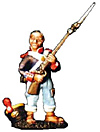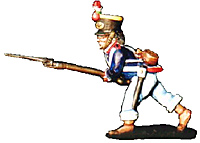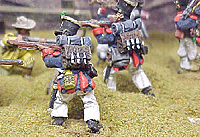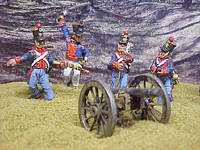The Alamo Part 1 The Mission San Antonio de Valero

In this second article the focus will be on the Mexican Army that took part in the thirteen-day siege of the Alamo. The Texian Defenders will be covered in Part 3 of this Alamo series.
Background in Brief
There are many misconceptions today about the quality and fighting skill of the Soldados that served in the Mexican Army as it prepared to march northward in order to crush the rebellion in the Mexican state of Coahuila y Texas in northern Mexico on 31 December 1835. To fully understand the present condition of the army one must have a brief knowledge of both its government and the man that led it during it’s Texas Campaign in 1836.
Mexico was bankrupt; it’s military barely existing on less than a shoestring budget. To complicate matters, the Mexican National Congress stripped the authority of it’s states and created a Centralized government on 3 October 1835 and by this action permitted it’s President and Supreme Commander, General Antonio de Lopez de Santa Anna, to become Mexico’s dictator. Responding to this new authority, Santa Anna wasted no time in abolishing the Constitution of 1824, which had permitted the Norteamericanos (US immigrants) to settle in the Texas territory. Whether his actions were justified, in part at least, is not an issue in this article. What is important is that his egotistical desire to gain status as a national Mexican hero, by driving the “foreign interlopers” out of Mexican territory would ultimately cost Mexico it’s northern territory and secure Texas her independence.
 On 30 October, the Mexican National Congress took another major step in resolving the problems in Texas by a force of arms. Santa Anna’s brother-in-law, General Perfecto Cos laid siege to San Antonio, which was quickly followed by a Texian delegation being formed to declare their independence from Mexico on 3 November 1835. Three weeks later the Texians, under the command of Colonel James Bowie, attacked a Mexican Army pack train south of San Antonio, in what is now called the “the Grass Fight. When San Antonio was captured by the Texians, under Colonel Ben Milam (who was killed on the 3rd day of the siege) and General Cos was forced to retreat, with his force of 1,000 men back across the Rio Grande River, Santa Anna was enraged. His brother-in-law had disgraced Mexico, and specifically it’s President. General Santa had to “save face” and so he departed from San Luis Potosi on 31 December and arrived in Saltillo a week later. Here he reviewed his army; an army that he was sure would crush the rebellious Texians with little effort.
On 30 October, the Mexican National Congress took another major step in resolving the problems in Texas by a force of arms. Santa Anna’s brother-in-law, General Perfecto Cos laid siege to San Antonio, which was quickly followed by a Texian delegation being formed to declare their independence from Mexico on 3 November 1835. Three weeks later the Texians, under the command of Colonel James Bowie, attacked a Mexican Army pack train south of San Antonio, in what is now called the “the Grass Fight. When San Antonio was captured by the Texians, under Colonel Ben Milam (who was killed on the 3rd day of the siege) and General Cos was forced to retreat, with his force of 1,000 men back across the Rio Grande River, Santa Anna was enraged. His brother-in-law had disgraced Mexico, and specifically it’s President. General Santa had to “save face” and so he departed from San Luis Potosi on 31 December and arrived in Saltillo a week later. Here he reviewed his army; an army that he was sure would crush the rebellious Texians with little effort.
By European standards, the Mexican Army lacked the luster and precision that was evident in the armies of Great Britain, France and Germany. Additionally, it was hardly in any condition to become involved in a winter campaign regardless of purpose. However, General Santa Anna’s plan, much like that of Napoleon, was strike the “rebels” quickly, on two parallel lines of advance before the Texians had sufficient time to react. As sound as the plan may have seemed, his army was ill prepared for the task at hand. Tight-fisted Quartermasters issued only 8 ounces of hard tack or toasted corn per day per soldier, which was hardly sufficient to sustain a man on a large march with a rifle and knapsack. Fresh water was not supplied and the men (except the higher officers grades) would have to depend on stagnant mud holes to satisfy their thirst. Many of the soldiers wore only sandals as they trudged through the bitterly cold desert while many others had no footwear at all. Although a great many of the soldiers were hardcore veterans, who had recently been involved in crushing the recent Federalist uprising in the state of Zacatecas, that recent campaign had drained the national treasury and produced a shortage of all supplies that would be burdened, as always, by the common soldier.
Although the Cavalry was well equipped and trained for the task before them, the Infantry Battalions were seriously lacking in both. The Permanente Infantry Battalions were made up of regular soldier who were veterans of many campaigns and could endure the harsh realities of a long winter march. The Activo Infantry Battalions, on the other hand, consisted of untrained conscripts and local militia, many of whom never fired their weapons much less engaged an enemy in actual combat. Each Infantry Battalions was supposed to have eight (8) companies of 80 men each, however, the actual number per company rarely exceeded 40 or 50 soldiers. Of the 13 Infantry Battalions that that were involved in Santa Anna’s siege of the Alamo only 5 were Permanente (Regular) units.
 Of the 8 companies within each Infantry Battalion, 6 were Fusileros Companies comprised of regular foot soldiers armed with East India Pattern British Brown Bess muskets. They formed the bulk of the fighting forces of each Infantry Battalion.
Of the 8 companies within each Infantry Battalion, 6 were Fusileros Companies comprised of regular foot soldiers armed with East India Pattern British Brown Bess muskets. They formed the bulk of the fighting forces of each Infantry Battalion.
Each Infantry Battalion also had a company of Cazadores, which served as Light Infantry and were roughly equivalent to the French Chasseurs. They were deployed as skirmishers and were armed with the more accurate British Baker Rifles.
The last unit within the Infantry Battalion was a Granaderos Company, which was considered to be the “elite” troops of the Battalion. They were usually held in reserve and were only deployed to stiffen up the nerve of the Fusileros or Cazadores when they faltered in battle. Like the regular troops, they were armed with East India Pattern British Brown Bess muskets.
Of the two types of muskets carried by the Infantry Battalions the Baker Rifled Musket was superior in range and accuracy to the Brown Bess. With a tight fitting ball and patch, it could hit a single target at about 100 yards and was dangerous against tightly packed infantry formations at a distance of almost 300 yards. However, poor powder quality, a loose fitting ball and patch, removed sights and the lack of experience and training of the average foot soldier rendered this or any type of weapon inaccurate to say the least.
Add to this that the final assault against the Alamo was made in the early morning darkness (5:30 AM) by tightly packed, running troops, that were trying to shoot and hit targets that were protected by the elevated walls of the Alamo it is not hard to understand that maximum effective range of either of these weapons probably did not exceed 40 yards.
 The Artillery
The Artillery
Of all the branches of service of the Mexican Army, none suffered a greater decline, since the Revolution of 1821, than the Artillery. A lack of funds disrupted the training of the gun crews and prevented the maintenance that was required to keep these field pieces combat worthy. Additionally, there were not enough gun crews to main these field pieces. To make matters even worse, of the 18 field pieces that were present during the actual siege, the majority were 6 and 8 pound pieces, which were hardly powerful enough to batter down the thick Alamo walls. Their greatest contribution to the whole affair was to be an annoyance and to deprive the defenders of their much-needed sleep and little else.
This, however, was not the case with the defender’s artillery pieces. They were loaded with “canister” rounds which virtually converted the field pieces in to giant shot guns that ripped through the tightly packed Mexican Infantry with deadly effect and without mercy. Only when the soldiers reached the Alamo North Wall were the Texians unable to sufficiently depress (lower) the gun tubes enough to continue the carnage. It is without question that more of the Mexican Infantrymen were killed or maimed as a result of these canister rounds then the musket fire from the 189 defiant riflemen that manned the walls of the Alamo. In regards to the Mexican Artillery, there is a common belief that General Santa Anna did not use his field pieces, during the infantry attacks on the last day of the siege, out of fear of killing his own troops. This gives credit where it is not due since the welfare of his men was the last thought on the dictator’s list of priorities. General Santa cared little for his men, which was clearly evident throughout his campaign. He elected not to use his artillery so that he would not awaken and alert the exhausted defenders while his Infantry Battalions crept up to with 200 yards of the Alamo walls in chilly, dark pre-dawn hours of that fateful Sunday morning on 6 March 1836.
Conclusion
Unfortunately, students of American history often view the Mexican Army that laid siege to the Alamo, especially the Infantry Battalions, as being a rag-tag collection of untrained and inexperienced peasants. Though there is some truth to this belief, it is far from being totally correct. Many historians also place the number of Mexican soldiers that assaulted the missions as being between 4,000 and 6,000 men with about 1,500 fatalities being sustained. Again, this is not true.
As to actual numbers, General Filisola places the total number of combatants in the Mexican Army of Operations at 6,019 when General Santa Anna was in Saltillo preparing for his Texas campaign. This was very impressive…. at least on paper. When Santa Anna arrived at San Antonio he had 1,700 men divided up in 6 Infantry Battalions, 185 elite Zapadores (Sappers), 290 men in his Cavalry and 18 field guns served by 100 crewmen. His total strength during the entire 13-day siege of the Alamo was 2,292 men plus his personal staff. The rest of his portion of the army was strung out along a 300 miles path and did not arrive until the morning of the final assault and after the siege was already over. Additionally, General Jose Urrea was given a considerable portion of the Army and was conducting separate military operations against the Texian “rebels” at San Patrico, Refugio, Goliad and Coleto Creek at the same time that Santa Anna was involved with the Alamo siege and his pursuit of Sam Houston’s army. Therefore, Lieutenant Jose de la Pina’s estimate of approximately 600 men being killed during the Alamo siege seems closer to the actual number.
As to the fighting qualities of the Mexican troops one cannot deny that it was lacking in many areas that were of no fault of the soldier themselves. A grueling 300 mile march, in the bitter cold, where men perished from disease and lack of proper food, while others froze to death does not inspire even the staunchest of troops to perform great deeds. Hitler’s and Napoleon’s campaigns in Russia, even with their elite troops, proved this.
A good portion of Santa Anna’s army were, as we stated earlier, mere conscripts that were “pressed” into service as the army passed through their small villages. Most of these men bore no ill feelings towards the Texian “rebels’ that they were being forced to fight nor did they have any interest in the issues that brought about this campaign in the first place. However, be that as it may, the point of a sword or bayonet was often used to force them to fall into line. Santa Ann’s reputation for executions, terrorism and cruelty were well known, even on the “frontier”, and to refuse his request meant certain death.
As to the bravery of the Mexican soldiers, this cannot be disputed. They charged head long, out of fear of Santa Anna’s wrath, directly into the deadly canister blast that decimated their ranks by the hundreds. Their initial attacks faltered, the men fell back and had to be forced to turn about in many cases. The Toluca Battalion lost 80% of its men by the time the Alamo siege was over about 90 minutes! Fighting, once the Mexican troops managed to breech the Alamo defenses, was hand-to-hand with an equally desperate foe that knew they were about to die. It was, without hesitation, a bloody and deadly affair for all involved. Remembering that many of the Mexican soldiers were not soldiers at all, but “civilians in uniform”, who were forced to endure many hardships throughout the campaign, one would have to say that the Soldados accounted well for themselves, all things being considered.
Credits
The 28mm Miniatures are from the Alamo and Texas War of Independence line by Cannon Fodder Miniatures.
Santa Anna’s Texas Campaign by Stephen L. Harfin
The Alamo…An Illustrated History by Edwin Hoyt
The Alamo Part 1 The Mission San Antonio de Valero
The Alamo Part 2 The Mexican Army
The Alamo Part 3 The Texan Defenders
The Alamo Part 4 Days of Glory
The Alamo: A Rebuttal Of Sorts
Back to Dispatch September 2003 Table of Contents
Back to Dispatch List of Issues
Back to MagWeb Master Magazine List
© Copyright 2003 by HMGS Mid-South
This article appears in MagWeb.com (Magazine Web) on the Internet World Wide Web. Other articles from military history and related magazines are available at http://www.magweb.com